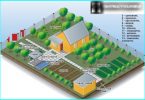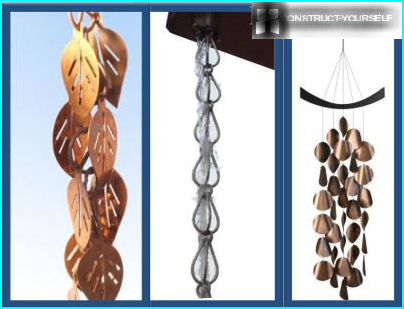
Soil is a living organism, which is constantly full of life. And the more bacteria, bugs, worms, the higher the quality, the better it grow garden culture. The owners sometimes do not quite understand what kind of soil is considered to be healthy and fertile. They make a large portion of chemical fertilizers, believing that improve the quality of the land. In fact, these feeding only affect plants, but did not contribute to the restoration of soil fertility. And it happens that the fertilizer remain in the soil, not assimilating plants, because the exhausted land they are not activated, turned in an easy to absorb form. Consider what determines soil fertility and how to improve it, if the country does not want anything to grow.
The contents
To plants lived in the land well, there must be moisture, oxygen and many nutrients. In addition, the soil needs to warm up well and have a normal acidity. Only in the presence of all this in the land of the many beneficial microorganisms that help plants eating quality. To the soil in the country met all the above requirements, it is necessary to work hard. So, let’s begin…
Water balance: not dry and not wet
Most often in country houses across the land on which the water either stagnant, or leaves, as through my fingers. Both for plants – certain death.
If you are not lucky, and on a plot of clay or low spot, the water in the soil will constantly. The only salvation for the lowlands is to hold the drainage. To do this along the fence dig a ten-foot wide strip of half a meter, depth meter. During the summer, throw all debris and stones that are found in the garden, and when you reach the level of fertile soil (about 40 cm) filled with soil taken from the next three meters. Once the first trench is buried, followed her along the fence dug up the second. And so – until the whole plot. The whole job will take about a season, but you’ll get rid of excess moisture in the soil.
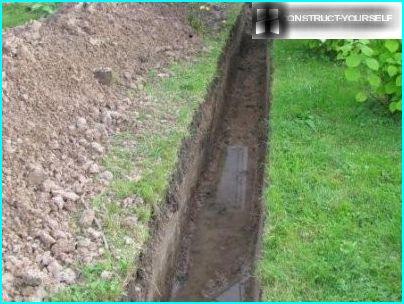
On the bottom of the trench is laid out any construction debris, broken bricks, stones, remains of blocks, and the top is filled with fertile soil on which to grow vegetables
You can also dig trenches and lay pipes, but in this case think through where the whole system out. You may have to dig the pool, so as not to drown the neighbors.
If the land is clay, the irrigation is not carried out, but only change the composition of the earth, diluting it with sand, peat and humus. The clay itself is very useful, because it keeps a lot of the right elements. But too much of it cements the share of land during a drought and preventing the roots to breathe, and in the rainy season in the garden is the lake. After filling, it is necessary several times to plow the soil with tillers, cultivator and then to porazbivat lumps into smaller particles and mixed components.
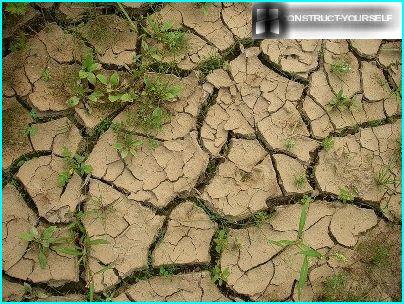
In clay soil the percentage of nutrients is very high, but due to the increased density and humidity, the roots are unable to obtain adequate food
If the area another problem is the sand, then we have to think how to retain moisture, not remove it. Completely change the composition of the earth for a season is unlikely to succeed. It’s a matter of time. You can only timely watering. There are seasons when the weather itself is not weak pours. And then the harvest will be excellent! To strengthen the soil, it is necessary to add humus, peat, clay, etc. are Very useful so-called «beet land». If your city is swakopund, where the fall brought on the change from collective farms beets, along with beet accumulates a lot of soil from the fields and bits of beets. If you agree with the employees of the company and ship a couple of cars land – your soil will be saved from dehydration. Anyway, this ground will have to be put somewhere. So why not at your cottage?!
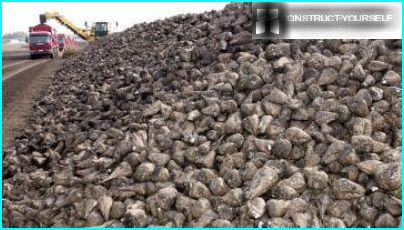
After harvesting the beet and loading it is a lot of ground, came in from the fields, and it can be used to improve soil fertility
Air mode: a «breathing» the earth?
The second component affecting the development of plants is oxygen. If it is small, if the soil is clogged, the roots will not be able to obtain adequate food.
First check, «breathe» whether your beds. To do this, simply pour on the ground a bucket of water and watch how it will absorb. If immediately began to cause the air bubbles so your land all right. If the water escapes without bubbles, then pores are clogged earth, and they should be open.
To make it easy. In the autumn when digging the soil don’t break blocks, and leave them hanging around by the waves. Over the winter the ground is deeply saturated with oxygen, and you will get rid of many of the pests that these blocks will freeze.
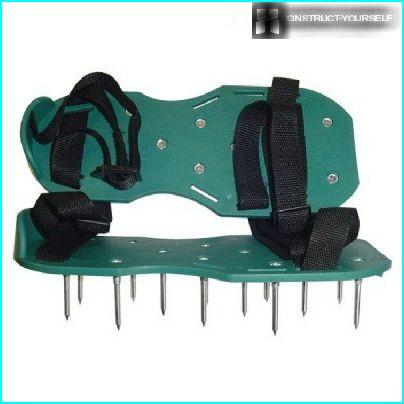
Pulling on leg aerator, you can improve the flow of air in the flower beds that are planted with perennials and shall not be digging
Useful device – an aerator (or hole punch). It was created to improve the ventilation on the lawns. Attached to the back side of the metal studs pierce the top layer of soil and create a path for air infiltration into the interior. This device is good to improve aeration flower beds that are not dug up for winter.
The earth’s heat: not cold and not hot
To adjust the temperature of the earth should the owners themselves. The darker the color of the soil, the more it warms up. Not every culture loves a hot land, so first determine what and where to grow, and then with the weather beginning to adjust the heat mode.
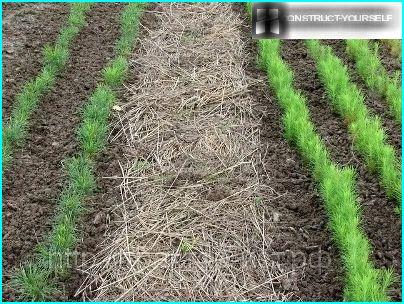
Mulch with straw beds become colder than the other by 2-3 degrees and protect plant roots from overheating and weeds
Raises the temperature:
- the creation of the ridges;
- mulching with peat or black earth;
- vystlannye black non-woven material with holes for the seedlings;
- vipaka weed.
Lowers the temperature:
- watering;
- loosening;
- mulch made from sawdust or straw.
- white non-woven fabric.
The acidity of the soil: pH 5.5 to achieve
As the earth gradually zakislate. A rare plant to live in acidic soil. Most prefer slightly acid ground, the pH of which is 5.5. Therefore, annual soil care should include liming.
First you need to determine how the land is sour. It is most convenient to collect a handful of soil from different places of the site and to take to a special lab. But if not, then the approximate acidity can be identified using a simple operation: lay on the piles of soil from several locations of the site and pour on top of the vinegar. If your piles began «boil» with the release of air bubbles – earth normal. If there was no reaction acid.
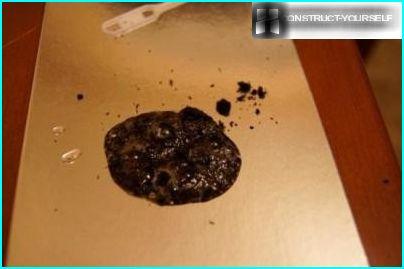
If you poured on the ground, the vinegar, and it began to appear bubbles, it means that the acidity of the soil normal
Why it is necessary to eliminate acidification:
- Acidic soil in the spring, long dry, and in the heat of a crust.
- They do not live beneficial bacteria.
- Acid binds phosphate fertilizers, not letting them be absorbed into the plants.
- Acid retains in the soil heavy metals.
To eliminate the acidification, it is necessary to buy a lime, put it out with water (50 kg – 2 buckets of water) to shed the earth to fall pereopisanie. Or make in the spring, before plowing.
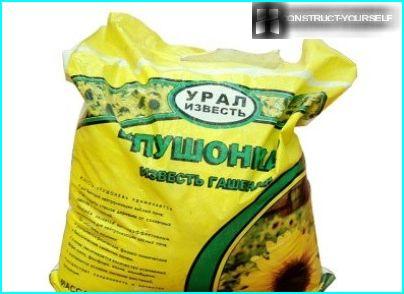
If the package is written with lime «slaked», so, it can be directly incorporated into the soil, gradually sprinkling in the beds
Can I sprinkle lime in powder, but before that let it rest for about a week in the open air, to put out due to the air moisture. To do this, simply cut the film package and leave it open on the street.
Roughly lime dose is 500 g for clay soils, 300 to sandy. If the exact degree of acidification is not defined, is it better to apply lime in small doses and observe the weeds. As soon as the beds disappeared plantain and horsetail – the acidity became neutral.
Life in the land of alive bacteria?
If all the above procedures have been conducted – the beneficial bacteria themselves will appear in your soil, because you have created all the conditions for their life of ease. And yet see how they are active. To do this, dig a few points of the plot filter paper, and after a month and a half, dig out and look at its condition.
- If it is almost decayed – life in the land of bubbling!
- If «melted» only partially – so, activity is average, and it is necessary to make organic fertilizer.
- If the sheet remained almost intact – it’s time to contribute nitrogen and organic fertilizers, and also to give rest to the soil. Maybe you a couple of seasons planted the same culture, thereby creating a base for the growth of harmful microbes. They ruined a useful biomaterial.
Need every year to change the composition of vegetables in the garden, that the soil is not exhausted from the waste product of one culture.






